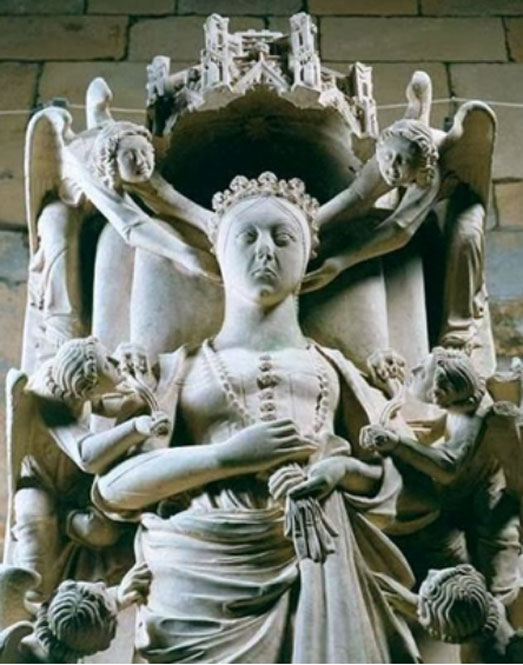
Was a Portuguese Queen Really Exhumed for her Coronation?
According to legend, in the mid-14th century a heart-broken King Peter (Pedro) I of Portugal exhumed the corpse of his lover to have her posthumously crowned queen. The romantic scandals of European royalty could fill a library so it can be difficult to find a story of a torrid liaison that stands out. But the tale of the coronation of Inês de Castro, the Corpse Queen of Portugal, is difficult to forget.
Inês de Castro was born sometime in 1325 to a noble family of Castilian descent from the Kingdom of Galicia, which was located in the northwestern part of the Iberian Peninsula. In 1340, when she was just 15 years old, Inês was sent to the court of Crown Prince Peter I of Portugal to be the lady-in-waiting to his wife, Constanza of Castile. However, the Peter and Inês fell in love and they started an affair.
- The Bizarre Importance of Bleeding Bodies in Medieval Trials
- Malevolent Phantoms, Corpse Brides, and Ancestor Spirits: The Ancient Belief in Ghosts – PART I
- The Mummy of Christian Friedrich von Kahlbutz, the Not So Chivalrous Knight
Constanza died five years later, in 1345, shortly after she gave birth to Ferdinand I, who was the future king of Portugal. After Constanza’s death, Peter asked his father, King Afonso IV, for permission to marry Inês. Afonso hoped to make a better match for his son and wanted his affair with her to end. So, in addition to refusing his son’s request, Afonso banished Inês from court. But her exile didn’t prevent the couple from continuing their relationship.
Peter and Inês moved to a villa near Coimbra that was dramatically dubbed the Villa of Tears. Between 1346 and 1354, Inês and Peter had four children, though only three survived infancy.
King Afonso IV and his advisers were afraid that Inês’ relationship with Pedro gave the Spanish influence over his son. So, he sent three assassins to Inês and Peter’s home in 1355 to put a violent end to their illicit affair. When the killers arrived at the villa, they found Inês and her children sitting near a fountain but Peter was nowhere to be found. Some sources say that she was stabbed to death another says she was beheaded in front of her children. Inês’ body was eventually buried at the Monastery of Santa Clara in Coimbra.

Murder of Inês de Castro. Painting by Columbano Bordalo Pinheiro, ca. 1901/04. (Public Domain)
When Afonso died in 1357, Peter inherited the throne and immediately set about getting revenge. He brought two of Inês’ three murderers to justice and had their hearts ripped out while he watched.
Peter declared that he and Inês married in secret and that she was the rightful queen of Portugal. He then ordered that her corpse be crowned during his coronation ceremony (another article says that her body was exhumed and crowned in 1361).
- Child Angels, Golden Boys, Supernatural Dolls and Necromancy in Thailand
- The Top Three Scientific Explanations for Ghost Sightings
- Queen of Sweden Says Her Old Palatial Home is Haunted by Friendly Ghosts
While this gesture was romantic, albeit creepy, it was also practical because it was attempt by Peter to legitimize his children with his lover.
Inês’ decomposing body was clothed in royal robes, a crown was placed on her head, and she was placed on a throne next to Peter in the Cathedral of Coimbra. Then he made all of the nobles line up to kiss her decaying hand.
An issue of Dublin Magazine published in 1852 describes the ceremony:
“Pedro, on occasion of his coronation, in the Cathedral of Coimbra, caused the corpse of Inez, in the Convent of Santa Clara, to be taken out, after having lain there from 1355 to 1357, dressed in royal robes, and placed on a throne beside him. He publicly swore to the fact of their marriage at Braganza, by a dispensation from Rome, caused her to be proclaimed queen, and crowned as such; and compelled all the nobles to do her corpse homage, and kiss the cold dead hand, jealously watching for any symptom of repugnance.”
After the ceremony, Inês’ body was taken to the Monastery of Alcobaça and placed in a tomb with her effigy. Her tomb faces Peter’s so they will rise facing each other during the Last Judgment.

The effigy on the tomb of Inês de Castro at the Monastery of Alcobaça. (Public Domain)
Many people believe the coronation of the Corpse Queen of Portugal is merely a legend and didn’t happen. This is probably because the idea of exhuming a dead body for a ceremony seems ridiculous. But the Catholic Church actually exhumed a dead pope for a trial known as the Cadaver Synod in 897 and asked him questions. So, the coronation of a dead queen is no less believable.
Top Image: ‘Le Couronnement d’Ines de Castro en 1361’ (The Coronation of Ines de Castro in 1361) by Pierre-Charles Comte (1849). Source: Public Domain
The above article, originally titled ‘Halloween Horror Post #1: The corpse queen of Portugal’ by Dolly Stolze was originally published on her blog Strange Remains and has been republished under a Creative Commons License.















